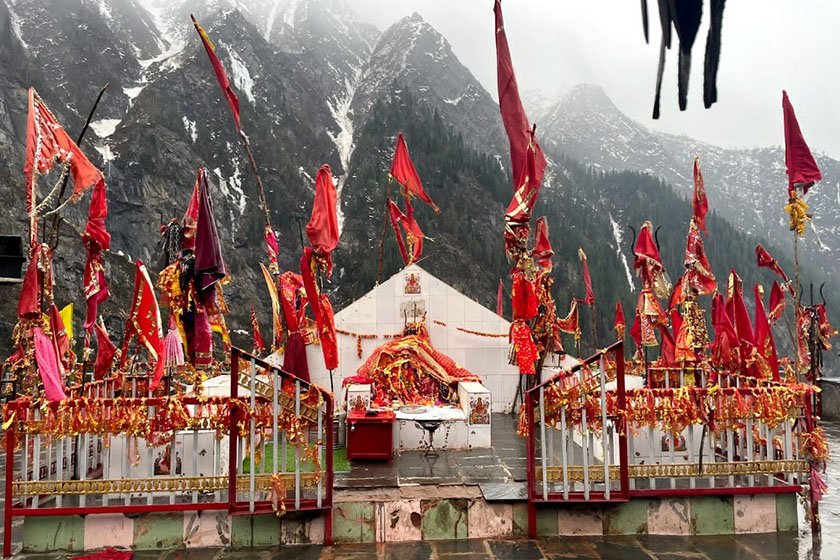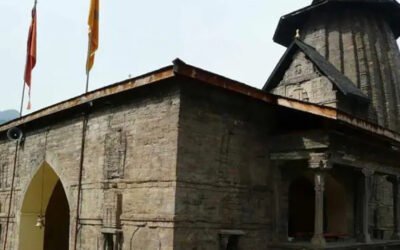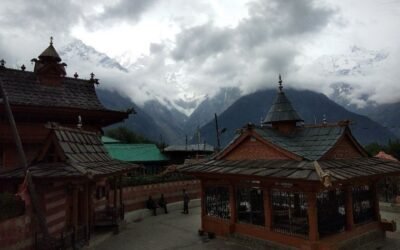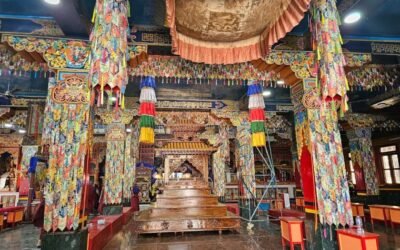Tucked deep within the Kugti Wildlife Sanctuary, at an altitude of 3,100 meters, the Kartik Swami Temple—also known locally as Kelang Wazir Temple—is a sacred Himalayan shrine dedicated to Lord Kartikeya, the warrior son of Lord Shiva. Revered by the Gaddi shepherds and pilgrims alike, this temple is a spiritual checkpoint before crossing the treacherous Kugti Pass into Lahaul.
🌄 Location & Accessibility
- Location: 6 km from Kugti village, Bharmour, Chamba district, Himachal Pradesh
- Altitude: ~3,100 meters above sea level
- Nearest Town: Bharmour (26 km from Kugti)
- How to Reach:
- By Road: Chamba → Bharmour → Hadsar → Kugti (motorable till Kugti)
- Trek: 6 km moderate trek from Kugti village to the temple
- By Rail: Nearest station – Pathankot (180 km)
- By Air: Gaggal Airport, Kangra (~130 km)
🛕 Mythological & Cultural Significance
Locally known as Kelang Wazir, Lord Kartikeya is worshipped as the guardian of the Kugti Pass. Before crossing into Lahaul, Gaddi shepherds seek his permission and blessings. If denied (through omens or dreams), they remain in the Kugti meadows for the season.
The temple complex also includes a shrine to Goddess Marali, believed to be Kartikeya’s sister. Rituals often involve sacrifices of sheep (symbolic or real) to ensure safe passage through the high-altitude terrain.
🕉️ Deity & Worship
The Kartik Swami Temple, also known locally as Kelang Wazir Temple, is dedicated to Lord Kartikeya, the warrior son of Lord Shiva and Goddess Parvati. Revered as Kelang Bajir by the Gaddi community, he is worshipped as the protector of high mountain passes, especially the treacherous Kugti and Jotnu Passes. The temple complex also includes a shrine to Goddess Marali, believed to grant safe passage and fertility.
The sanctum houses a metal idol of Kartikeya holding a staff and ring, along with a marble image and a wooden effigy offered by devotees. Worship rituals include offerings of red cloth, incense, and ghee lamps, and during the seasonal migration, Gaddi shepherds perform animal sacrifices (traditionally sheep) to seek divine permission for crossing the passes. Devotees pray for courage, protection, and success in difficult journeys, and the temple is especially active between April and October, when it opens for pilgrimage. The deity is also honored through ritual dances performed by red-capped disciples known for their spiritual fervor.
🏛️ Temple Highlights
- A stone and wood temple with traditional Himachali architecture
- Surrounded by alpine meadows, waterfalls, and snow-capped peaks
- Offers panoramic views of the Pir Panjal range
- A sacred spring nearby is believed to have healing properties
- The temple is open from April 13 (Baisakhi) to Diwali, and remains snowbound in winter
🎉 Festivals & Rituals
- Kelang Wazir Mela (August–September): A local fair with folk music, dance, and offerings
- Kartik Swami Mela (November): Celebrated with ritual dances and community feasts
- Daily Worship: Devotees offer red flags, incense, and ghee lamps
- Gaddi Rituals: Before crossing Kugti Pass, shepherds perform sacrificial rites and seek divine approval
🏞️ Nearby Attractions
- Kugti Village: A traditional Gaddi settlement with Khat-Kuni architecture
- Kugti Wildlife Sanctuary: Home to snow leopards, Himalayan black bears, and musk deer
- Manimahesh Lake: A sacred glacial lake, 13 km from Hadsar
- Chaurasi Temple Complex, Bharmour: A cluster of 84 ancient shrines
- Bharmani Mata Temple: A hilltop shrine with panoramic views
🙏 Spiritual Experience
The Kartik Swami Temple is not just a shrine—it’s a threshold between the known and the mystical. As you ascend through pine forests and alpine meadows, the silence deepens, and the presence of the warrior god becomes palpable. Whether you’re a pilgrim, a trekker, or a seeker of solitude, this temple offers a rare communion with the divine and the wild.




